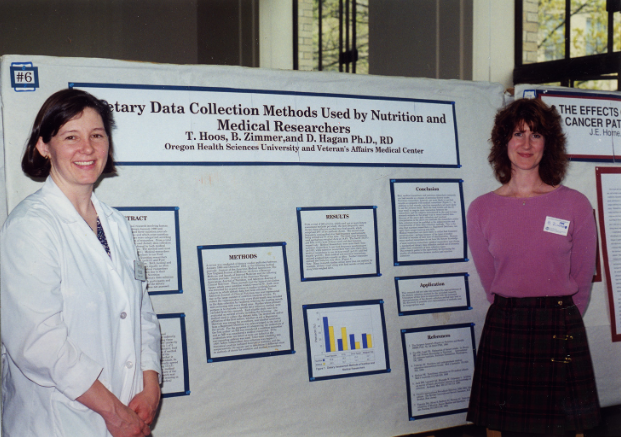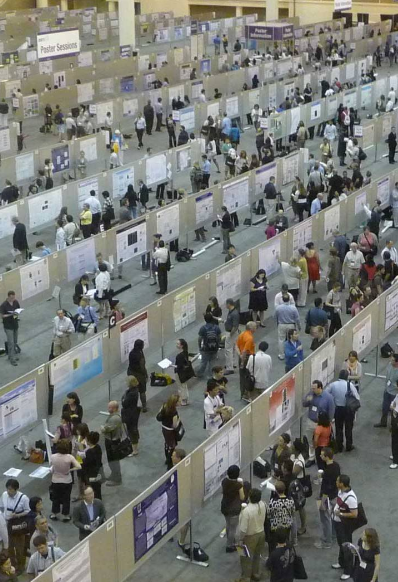The advent of the poster session revolutionized the way we share, collaborate, and connect in the world of academia and research. While ePosters have been in use for over a decade, many people still think of rows of poster boards when asked to imagine a poster session. The truth is that the landscape of poster sessions (and scholarly communications in general) has undergone a significant transformation due to technology.
But have you ever wondered, what was it like at the first ever poster session? And how did people share their research before major technological advancements like the internet? This week we’re sharing a historical overview of how the poster session came to be, a look at how posters were revolutionized by technology, and our predictions of how we see the poster session changing in years to come.
The Past: A World Without ePosters
The inclusion of poster sessions at conferences is a surprisingly modern thing. While we can track academic and scientific conferences, in some format or another, all the way back to 1860 when the first international scientific conference took place in Germany, poster sessions didn’t appear on the scene until a century later in the late 1960s.
These early poster sessions were extremely basic, with individual graphs, diagrams, and text printed or drawn onto individual pieces of paper and pinned onto larger boards. This was the norm right into the 1980s, before large-scale printing was an option.

Photo courtesy of the Dorothy W. Hagan photograph collection, 1932-2002, Collection Number 2006-013, Oregon Health & Science University, Historical Collections & Archives
By the time we reach the 2000s, poster sessions had become an integral feature of the scientific or academic conference with thousands of posters being displayed at large international events.

Photo by Steven Rose, 111th American Society for Microbiology General Meeting, New Orleans, LA 2011
While technology developed and tech got smarter and smaller, the conference poster languished in the low-tech, space hogging, litter-creating format of its origins. There have been attempts by creative presenters to bring an element of interactivity and technology to posters, ranging from the Digital Legacy Association’s attempt at a polling feature, to tech-minded students finding ways to attach tablets to their posters to display videos.

Photo by Paulbacca, “Interactive Conference Poster Presentation”, published on Autodesk Instructables
The Present: Embracing the Digital Era of ePosters
While for many digital posters may seem like the future, it was actually back in 2010 when ePostersLive first started offering a digital poster solution to bring posters into the 21st century. By 2011 we went international, supporting the Royal College of Obstetrics and Gynecology, an event we worked with yet again at the end of 2022, over a decade later! The future is already here.
By 2012 it was clear that e-posters were the wave of the future, and that technology was going to transform the scientific conference experience. That year, Nature interviewed our CEO Pavlos Moustakidis, who successfully predicted many of the current trends regarding interactivity and hybrid models. The Nature article signaled that the scientific community at large had embraced electronic posters, and ePostersLive was at the forefront of this progress.

ePostersLive™ in action at the 9th International Scientific Meeting of the Royal College of Obstetricians and Gynaecologists, September 2011
Since that first session, technology has continued to evolve and we now see innovative, engaging, and interactive posters being displayed in a digital format all over the world. Recently we’ve worked with events that have encouraged authors to add video or audio to their posters to give more interaction and engagement. Commenting and contacting tools help the conversation carry on well after an event has ended. Touchscreen compatibility allows the reader to literally zoom in on even the tiniest data point. We’ve even supported totally virtual sessions with delegates dialing in from across the globe to engage with authors.

ePostersLive™ in action at the 2022 ASA Annual Meeting, October 2022
The Future: ePostersLive in the Vanguard of Scientific Communication
Ultimately, there is always room for growth. Especially when it comes to accessibility and ease of scholarly communication, in the case of eposters. Recent trends toward improving interactivity and poster engagement are coming alongside a wider shift in how authors choose to format and design their posters, like the #BetterPoster movement. The good news is that at each conference, we continue to see researchers try new things and experiment with how to present their work in the most meaningful and lasting way possible.
It’s safe to say there are some exciting advancements on the horizon, at ePostersLive and beyond. We can’t wait to see what the next stage in poster session innovation will be, but you can be sure it will be SciGen Technologies leading the way once again.
